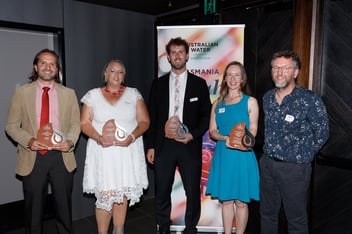Improvements for the kanamaluka / Tamar estuary
.jpg)
For the past four years, Northern Tasmanians have collaborated on targeted projects to improve the health of the kanamaluka / Tamar estuary, by helping to keep pathogens out of local waterways.
A bid to improve public amenity and waterway health has seen collaboration between farmers,
environmental scientists, engineers, community organisations and everyday people through the
Tamar Estuary River Health Action Plan - Catchment Works Program.
Monitoring of enterococci bacteria is used as an indicator of the potential presence of disease-causing pathogens, which are typically introduced into water supplies through faecal contamination.
Catchment modelling from March 2022 has already shown a 7.3 per cent reduction in median
enterococci bacteria concentrations – far more than the 4.7 per cent target – and there is still a year
of project activities in the pipeline to be completed.
NRM North Water Program Manager Jesse Webster said the catchment works, which are an initiative
of the Launceston City Deal, includes two key components: the Tamar Action Grants (TAG) and the
Sewage Intrusion Project.
“Since its launch in 2019, the TAG program has supported 184 projects involving 150 landholders to
install livestock-exclusion fencing along waterways, and helped dairy farmers improve effluent
management, reducing pathogens from entering waterways,” Mr. Webster said.
“Keeping livestock out of waterways in the catchment has significant water quality benefits that carry
into the estuary.
“Installing fences also protects the riparian zone – that’s the area next to the river which provides
significant ecological functions as well as habitat and biodiversity benefits.”
As of December 2023, the grants have supported installation of 548 km of stock exclusion fencing on
grazing and dairy farms. Cumulatively, this has seen more than 2,322 hectares of stream side habitat
protected for regeneration.
Meanwhile, with the support of industry body DairyTas, effluent management has been improved
across 2,600 hectares of dairy pasture.
Mr Webster said the other major element of the Catchment Works Program, the Sewage Intrusion
Project, aimed to locate and rectify sewage intrusions within Launceston's stormwater network.
“This involved the investigation of 13 stormwater catchments and rectified 44 crossed connections
between stormwater and sewer pipes,” Mr Webster said.
“Those works alone are estimated to prevent 13 megalitres of untreated sewage entering the estuary
annually which is equivalent to five and half Olympic sized swimming pools.”
Mr. Webster said while the primary focus of the Catchment Works Program is to reduce the median
enterococci bacteria concentration in Zone 1 of the estuary (the area from Launceston to Legana), the
actions have also led to significant secondary benefits.
“Farmers tell us that preventing livestock drinking from the river can significantly reduce the
likelihood they would contract water-borne illnesses such as liver fluke. These illnesses can result in
weight loss, liver damage and loss in production,” Mr. Webster said.
“Once stock are removed from a waterway, the riparian vegetation can regenerate, which reduces
bank erosion and increases resilience to flood events.
“Healthy native riparian vegetation forms an important part of a healthy functioning ecosystem and
has many environmental benefits like reducing nitrogen, phosphorus and suspended solids from
entering the river."
Catchment modelling from March 2022 found a four per cent reduction in average nitrogen and
phosphorous concentration and an eight per cent reduction in the average concentration of
suspended solids within the upper kanamaluka / Tamar estuary.
“Combined there are other secondary benefits that will take years to be fully realised. For example,
the riparian zones may take up to 15 years to regenerate from what they are now, but each year there
will be further ecological benefits as the vegetation matures,” Mr. Webster said.
This program is supported with funding from the Tasmanian and Australian Governments through the
Launceston City Deal ‘working together for healthy waterways’.
.jpg?width=800&height=533&name=TAG258%20Andrew%20Pedley%20-%20Pro%20Photo%20(08).jpg)


